会计学11章习题及答案
自考会计制度设计第11章2008年至2018年10月试题及答案
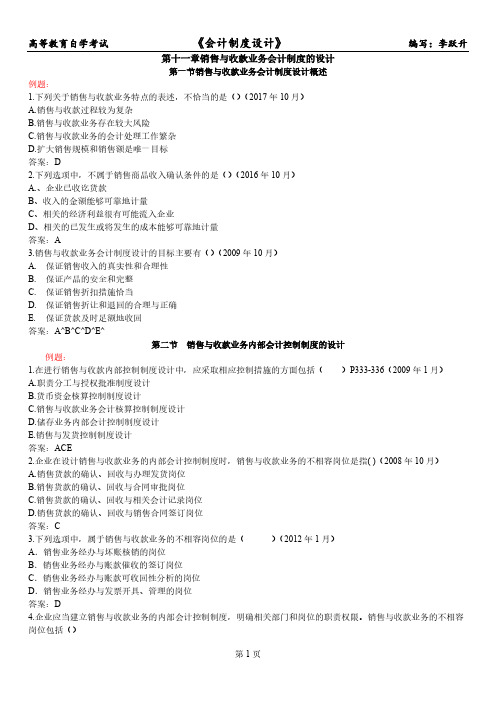
并归档保存,作为仓库盘存的依据:会计部收到销货单后,根据单中所列资料,开具统一的销售发票,将客户联寄 送顾客,将销售联交应收账款管理员丙,作为记账和收款的凭证:应收账款管理员丙收到发票后,将发票与销货单
核对,根据此单登记应收账款明细账,并将发票和销货单按客户顺序归档保存。要求:分析指出该企业销售与收款 内部会计控制制度存在的不足。
答: (1)该企业销售与收款业务存在如下问题: 1)信用管理部门由销售部门兼任,易造成销售部门滥用信用政策,损害企业利益。 2)大额销售业务的定价权及签署合同均由销售部门自主完成 ,销售部门权限过大,不利于销售业务的内部控制。 3)由业务员向客户收取现金,容易引起舞弊。 4)逃避银行监控,设立账外账。 5)销售退回制度存在漏洞,被销售人员利用从事个人私利的舞弊活动,损害企业利益。 (2)对企业销售与收款业务的内部控制制度进行如下的改进: 1)设立专门的信用管理部门,负责制定企业信用政策并监督各部门执行。 2)建立销售定价控制制度,统一制定价目表,定期审阅并严格执行。 3)严格按照程序办理大额销售业务,指定专门人员与客户谈判,对销售合同明确具体的审批程序和涉及的部门人员, 根据企业的实际情况明确界定不同合同金额审批的具体权限分配,金额重大的销售合同应征询法律顾问或专家的意 见。
会计学习题及答案 (11)
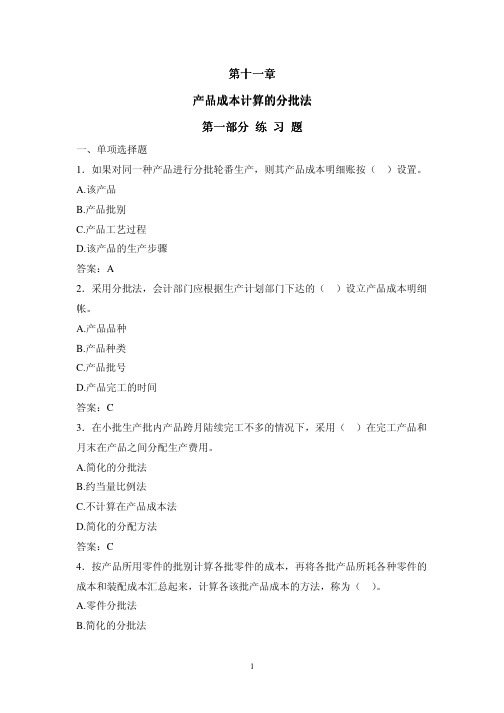
2.简化的分批法,就是不分批计算在产品成本的分批法、累计生产费用分批法。
(√)
3.简化的分批法必须设置基本生产成本二级帐,其他的成本计算方法,可以不设
立基本生产成本二级帐。
(√)
4.简化的分批法下,某项累计间接费用分配率等于全部产品该项累计间接费用除
以全部完工产品累计生产工时。
(√)
5.简化的分批法下,生产费用的横向分配工作和纵向分配工作,到月末一起进行。
17.分批法的成本计算对象可以是一张定单中规定的几种产品,也可以是一件产
品的组成部分。
(√)
18.会计部门应根据销售部门接受的定单,设立产品成本明细帐。
(×)
19.采用分批法,在月末计算成本时,不存在在完工产品与在产品之间分配费用
的问题。
(×)
20.在分批法下,如果批内产品跨月陆续完工的情况不多,且批量不太,可采用
5
10.简化的分批法的特点是( )。
A.每月发生的备项间接计入费用,不是按月在各批完工产品之间进行分配
B.每月发生的各项间接计入费用,不是按月在各批在产品之间进行分配
C.累计间接计入费用,在产品完工时,按完工产品累计生产工时比例,在各批完
工产品之间进行分配
D.各月不在完工产品与在产品之间分配费用
答案:ABC
简便的分配方法计算先完工产品成本,但在该批产品全部完工时,对已经转帐的
完工产品成本,应作帐面调整。
(×)
21.简化的不分批计算在产品成本的分批法适用于同一月份内投产的产品批数很,也就是不分批计算在产品成本的分批法。
(√)
23.简化的分批法,在各该批产品完工以前,产品成本明细帐只需按月登记直接
产工时计算登记 A B.各批产品成本明细帐中月末在产品的各该直接费用和生产工时分别汇总登记 C.各批产品成本明细帐中月初在产品的各该直接费用和生产工时分别汇总登记 D.各批产品成本明细帐中月末在产品的生产费用和生产工时分别汇总登记 E.本月发生的直接费用和生产工时登记 答案:AB 4.基本生产成本二级帐中月末在产品的各项间接费用,可以根据( )。 A.本月发生的间接费用登记 B.月初在产品的间接费用登记 C.各批产品成本明细帐中月末在产品的间接费用汇总登记 D.各该费用的累计数减去完工产品的相关费用计算登记 E.月末在产品生产工时分别乘以各该费用的累计分配率计算登记 答案:DE 5.下列情况中,适宜采用简化分批法的是( )。 A.投产批数多,完工批数多 B.投产批数多,完工批数少
会计学(第三版):习题答案及解析

谢谢观看
读书笔记
读书笔记
这是《会计学(第三版):习题答案及解析》的读书笔记模板,可以替换为自己的心得。
精彩摘录
精彩摘录
这是《会计学(第三版):习题答案及解析》的读书笔记模板,可以替换为自己的精彩内容摘录。
作者介绍
同名作者介绍
这是《会计学(第三版):习题答案及解析》的读书笔记模板,暂无该书作者的介绍。
目录分析
第1章导论 第2章资产负债表
第3章利润表 第4章现金流量表
第6章货币资金和 应收项目
第5章会计报表分 析
第7章存货
01
第8章投资 和合并会计 报表
02
第9章固定 资产、无形 资产及其他 资产
03
第10章负 债
04
第11章股 东权益
06
第13章成 本核算题
一、思考题 二、练习题 三、讨论题
第6章货币资金和应收项目
一、思考题 二、练习题 三、讨论题
第7章存货
一、思考题 二、练习题 三、讨论题
第8章投资和合并会计报表
一、思考题 二、练习题 三、讨论题
第9章固定资产、无形资产及其他资产
一、思考题 二、练习题 三、讨论题
第10章负债
一、思考题 二、练习题 三、讨论题
会计学(第三版):习题答案 及解析
读书笔记模板
01 思维导图
03 目录分析 05 精彩摘录
目录
02 内容摘要 04 读书笔记 06 作者介绍
思维导图
本书关键字分析思维导图
学生
预算
习题
项目
控制
解析
利润表
会计学
教材
习题 章
净现金
版
会计报表
会计学(上海财经大学)知到章节答案智慧树2023年
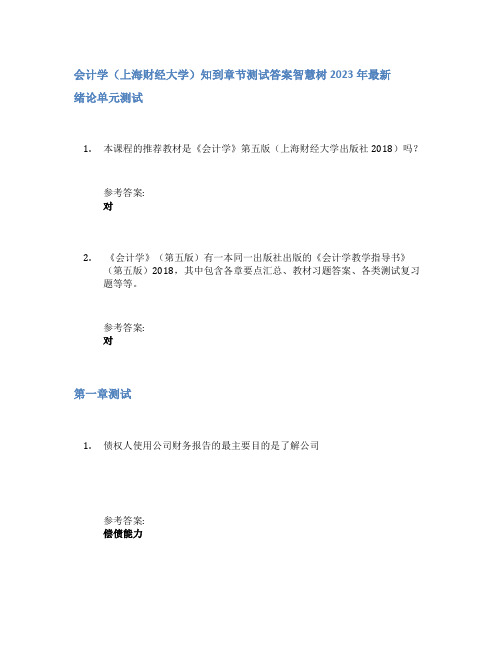
会计学(上海财经大学)知到章节测试答案智慧树2023年最新绪论单元测试1.本课程的推荐教材是《会计学》第五版(上海财经大学出版社2018)吗?参考答案:对2.《会计学》(第五版)有一本同一出版社出版的《会计学教学指导书》(第五版)2018,其中包含各章要点汇总、教材习题答案、各类测试复习题等等。
参考答案:对第一章测试1.债权人使用公司财务报告的最主要目的是了解公司参考答案:偿债能力2.以下信息使用人中属于内部使用人的是参考答案:企业管理部门3.反映一定时期内企业收入、费用和利润情况的是参考答案:利润表4.下列哪项属于利润表反映的内容?参考答案:收入5.股东决策所依据的信息包括以下:参考答案:公司其他有关信息;行业发展信息;相关行业信息;公司财务信息6.财务报告反映公司财务信息,财务报告的使用人包括以下哪些?参考答案:公司股东;公司管理层;债权人 ;税务部门7.主要的财务报表有参考答案:现金流量;经营成果;财务状况8.资产负债表能提供企业某一特定日期的()。
参考答案:财务弹性信息;负债总额;资产总额和结构信息9.证券监管部门也是财务报告的使用人。
参考答案:对10.企业销售业务带来的收入会导致企业经济利益的流入,但并不意味着该业务一定给企业带来利润。
参考答案:对第二章测试1.资产类账户借方反映资产的()参考答案:增加2.甲公司2016年3月25日以银行存款偿还乙公司一笔应付账款,该项经济业务对会计等式产生的影响是?参考答案:负债减少,资产减少3.甲公司2017年2月12日预收客户货款13,000元,商品尚未交付,为此,需要编制()会计分录。
参考答案:借:银行存款 13,000贷:预收账款 13,0004.甲有限责任公司所有者2018年1月3日投入600,000元创建公司,款项已经存入银行,对该项经济业务,需要编制的会计分录是?参考答案:借:银行存款 60,000贷:实收资本: 60,0005.甲公司于2018年6月以银行存款支付管理人员工资4,500元,对于该项经济业务,甲公司应记录如下:参考答案:借:管理费用 4,500贷:银行存款 4,5006.资产具有以下哪些特征参考答案:能够为企业带来经济利益;在过去交易或事项中形成;为企业所拥有7. 2. 经济业务的发生可能导致会计等式发生如下变化:参考答案:一项资产增加,一项负债增加;一项资产增加,一项所有者权益增加;一项负债减少,一项所有者权益增加8.在借贷记账法下,账户的借方可以登记?参考答案:资产的增加;费用的增加;收入的减少9.2018年5月5日,甲公司销售一批商品,销售价格5,000元,该批产品实际成本1,200元,商品已经发出且款项已经收到。
2010年初级会计职称考试初级会计实务章节习题及答案解析(11)
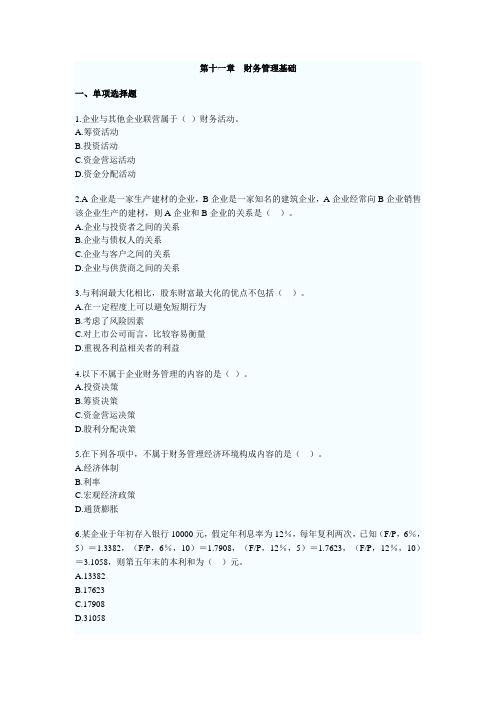
第十一章财务管理基础一、单项选择题1.企业与其他企业联营属于()财务活动。
A.筹资活动B.投资活动C.资金营运活动D.资金分配活动2.A企业是一家生产建材的企业,B企业是一家知名的建筑企业,A企业经常向B企业销售该企业生产的建材,则A企业和B企业的关系是()。
A.企业与投资者之间的关系B.企业与债权人的关系C.企业与客户之间的关系D.企业与供货商之间的关系3.与利润最大化相比,股东财富最大化的优点不包括()。
A.在一定程度上可以避免短期行为B.考虑了风险因素C.对上市公司而言,比较容易衡量D.重视各利益相关者的利益4.以下不属于企业财务管理的内容的是()。
A.投资决策B.筹资决策C.资金营运决策D.股利分配决策5.在下列各项中,不属于财务管理经济环境构成内容的是()。
A.经济体制B.利率C.宏观经济政策D.通货膨胀6.某企业于年初存入银行10000元,假定年利息率为12%,每年复利两次,已知(F/P,6%,5)=1.3382,(F/P,6%,10)=1.7908,(F/P,12%,5)=1.7623,(F/P,12%,10)=3.1058,则第五年末的本利和为()元。
A.13382B.17623C.17908D.310587.企业有一笔5年后到期的贷款,每年年末归还借款3000元,假设贷款年利率为2%,则企业该笔贷款的到期值为()元。
已知(F/A,2%,5)=5.2040,(P/A,2%,5)=4.7135A.15612B.14140.5C.15660D.183728.已知利率为10%的一期、两期、三期的终值系数分别是1.1、1.21、1.331,则可以判断利率为10%,3年期的年金终值系数为()。
A.3.31B.2.4868C.3.2654D.3.6419.在利率为10%的条件下,一至三年期的复利现值系数分别为0.9091,0.8264,0.7513,则三年期的年金现值系数为()。
A.2.4868B.1.7355C.0.7513D.2.735510.已知(F/A,10%,9)=13.579,(F/A,10%,11)=18.531。
会计学(山东管理学院)知到章节答案智慧树2023年
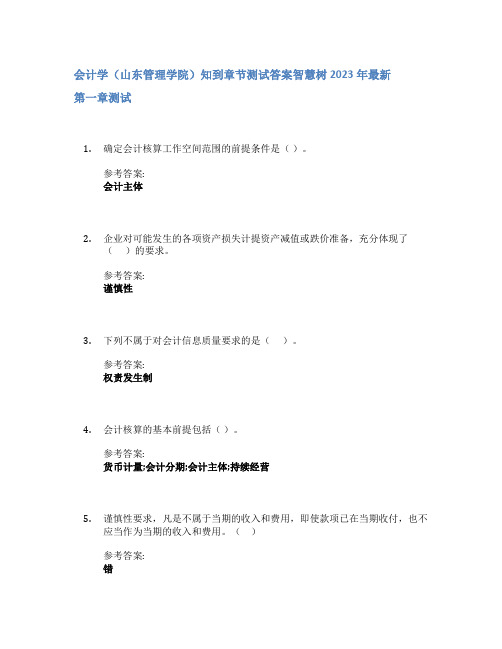
会计学(山东管理学院)知到章节测试答案智慧树2023年最新第一章测试1.确定会计核算工作空间范围的前提条件是()。
参考答案:会计主体2.企业对可能发生的各项资产损失计提资产减值或跌价准备,充分体现了()的要求。
参考答案:谨慎性3.下列不属于对会计信息质量要求的是()。
参考答案:权责发生制4.会计核算的基本前提包括()。
参考答案:货币计量;会计分期;会计主体;持续经营5.谨慎性要求,凡是不属于当期的收入和费用,即使款项已在当期收付,也不应当作为当期的收入和费用。
()参考答案:错6.确立会计核算空间范围所依据的会计基本假设是()。
参考答案:会计主体7.关于会计基本假设的表述不正确的是()。
参考答案:固定资产采用历史成本计量是以会计分期为前提的8.下列各项中,关于会计基础的说法不正确的是()。
参考答案:企业可以选择按权责发生制或收付实现制进行会计核算,一经确定,不得变更9.会计主体是指会计确认、计量和报告的空间范围,下列各项中可以作为会计主体的有()。
参考答案:合伙企业;个体工商户;独立核算的分支机构;独资公司10.下列各项中,关于费用的说法不正确的有()。
参考答案:费用会导致资产的增加或负债的减少;企业报废固定资产的净损失应确认为企业的费用;企业向投资者分配利润发生的现金流出应确认为企业的费用11.所有资产都应该采用历史成本计量。
参考答案:错第二章测试1.复式记账法的理论依据是()参考答案:资产=负债+所有者权益2.为了保证账户对应关系的清晰,一般情况下不宜编制()分录。
参考答案:多借多贷3.账户是根据()开设的,用来连续、系统地记录各项经济业务的一种工具。
参考答案:会计科目4.以下哪些错误无法通过试算平衡表发现()参考答案:借贷双方同时多记金额;某项经济业务未入账;某项经济业务重复入账;应借应贷账户借贷方颠倒;借贷双方同时少记金额5.所有经济业务,都会引起会计等式两边发生变化()。
参考答案:错6.会计科目和账户之间的联系是()。
初级会计实务章节测试题及答案第十一章
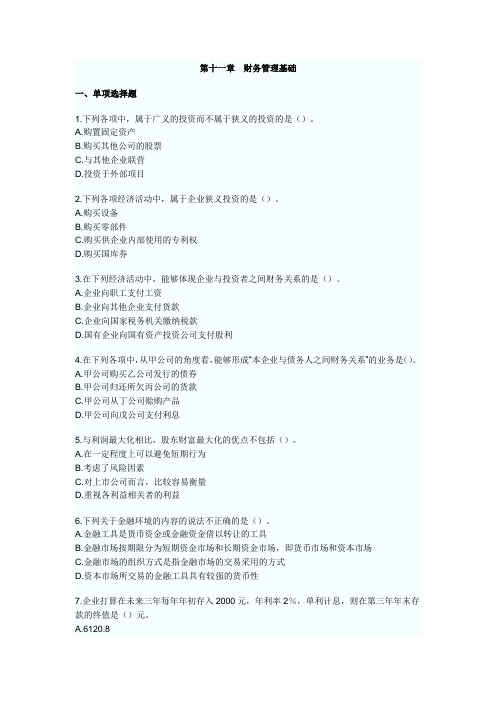
第十一章财务管理基础一、单项选择题1.下列各项中,属于广义的投资而不属于狭义的投资的是()。
A.购置固定资产B.购买其他公司的股票C.与其他企业联营D.投资于外部项目2.下列各项经济活动中,属于企业狭义投资的是()。
A.购买设备B.购买零部件C.购买供企业内部使用的专利权D.购买国库券3.在下列经济活动中,能够体现企业与投资者之间财务关系的是()。
A.企业向职工支付工资B.企业向其他企业支付货款C.企业向国家税务机关缴纳税款D.国有企业向国有资产投资公司支付股利4.在下列各项中,从甲公司的角度看,能够形成“本企业与债务人之间财务关系”的业务是()。
A.甲公司购买乙公司发行的债券B.甲公司归还所欠丙公司的货款C.甲公司从丁公司赊购产品D.甲公司向戊公司支付利息5.与利润最大化相比,股东财富最大化的优点不包括()。
A.在一定程度上可以避免短期行为B.考虑了风险因素C.对上市公司而言,比较容易衡量D.重视各利益相关者的利益6.下列关于金融环境的内容的说法不正确的是()。
A.金融工具是货币资金或金融资金借以转让的工具B.金融市场按期限分为短期资金市场和长期资金市场,即货币市场和资本市场C.金融市场的组织方式是指金融市场的交易采用的方式D.资本市场所交易的金融工具具有较强的货币性7.企业打算在未来三年每年年初存入2000元,年利率2%,单利计息,则在第三年年末存款的终值是()元。
A.6120.8B.6243.2C.6240D.6606.68.2010年1月1日,张先生采用分期付款方式购入商品房一套,每年年初付款15000元,分10年付清。
张先生每年年初的付款有年金的特点,属于()。
A.普通年金B.递延年金C.即付年金D.永续年金9.归国华侨郝先生想支持家乡建设,特地在祖籍所在县设立奖学金,奖学金每年发放一次,奖励每年高考的文理科状元各10000元,奖学金的基金存入中国银行。
每年发放的奖学金有年金的特点,属于()。
《财务会计学》第七版笔记和课后习题(含考研真题)详解第11章

广义费用可以分为本年税前费用和所得 税两部分。本年税前费用除了包括狭义费用 之外,还包括公允价值变动损失、资产减值 损失和营业外支出。公允价值变动损失是指 交易性金融资产等公允价值变动形成的损失; 资产减值损失是指各项资产发生减值形成的 损失;营业外支出是指企业在经营业务以外 发生的支出。所得税费用是指应在会计税前 利润中扣除的所得税费用。
有时,企业已将商品所有权凭证或实物移 交给买方,但尚未完成商品的安装或检验工作, 且商品的安装或检验工作是销售合同的重要组 成部分;或销售合同规定了退货条款,且企业 又不能确定退货的可能性。
在这种情况下,商品所有权上的主要风险 和报酬并未真正转移给买方,因而不能确认销 售商品收入。
(2)企业既没有保留通常与所有权相联系 的继续管理权,也没有对售出的商品实施控制。
第二节 利润总额的形成
一、营业收入与营业费用的确认 (一)营业收入的确认 1.营业收入的范围 2.销售商品收入的确认与计量 3.提供劳务收入的确认与计量 4.让渡资产使用权收入的确认与计量
1.营业收入的范围 营业收入是指企业在从事销售商品、提供 劳务和让渡资产使用权等日常经营业务过程中 取得的收入,分为主营业务收入和其他业务收 入两部分。 主营业务收入是指企业进行经常性业务取 得的收入,是利润形成的主要来源。不同行业 主营业务收入的表现形式有所不同。 其他业务收入是指企业在生产经营过程中 取得的除主营业务收入以外的各项收入,如转 让无形资产使用权的收入等。
100件,价款100 000元,增值税17 000元,用银
行存款代垫运杂费200元,已办妥托收手续。
借:应收账款
117 200
贷:主营业务收入
100 000
应交税费—应交00
(3)7日,采用赊销方式销售甲产品30件,价款
11章所有者权益
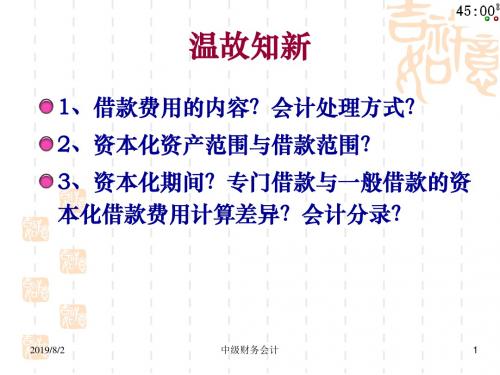
借:银行存款
12000万(1.2亿)
贷:股本
2000万
资本公积——股本溢价 10000万
借:资本公积——股本溢价 100万
贷:银行存款
100万
2019/8/2
中级财务会计
34
中 级会计学 Intermediate Accounting
10 所有者权益
例题
SK股份有限公司按面值发行5000万股股票, 每股面值1元,发行手续费为发行收入的2.5%, 发行手续费已由受托的证券发行商从发行收入中 扣除,余款由SK公司收存银行。 (这个会计处理可能要重述!)
留存收益
盈余公积和未分配利润
①付给股东的款项是利润的分配还是投入资本的返还 ②股东用累计利润来衡量管理人员的业绩
2019/8/2
中级财务会计
8
★全面收益观(已现实与可现实) 与资本保全(拓展知识)
资本保全概念
货币资本保全 一般购买力资本保全 实物资本保全
2019/8/2
中级财务会计
9
三、不同组织形式的企业所有者权益特征
2
中 南 财 经 政 法 大 学 ·会 计 学 院
中 级会计学 Intermediate Accounting
10 所有者权益
学习目的与要求
掌握所有者权益的构成及其相应的经济涵义 掌握投入资本和资本公积的会计处理方法 掌握股票发行的会计处理方法 理解普通股和优先股的性质和权利 掌握留存收益的会计处理方法
=200万÷(1-20%)=250万
D享有注册资本的份额=250万×20%=50万
D加入的分录:
借:银行存款
60万
贷:实收资本——D
50万
资本公积——资本溢价 10万
第十一章 账务处理程序习题及参考答案
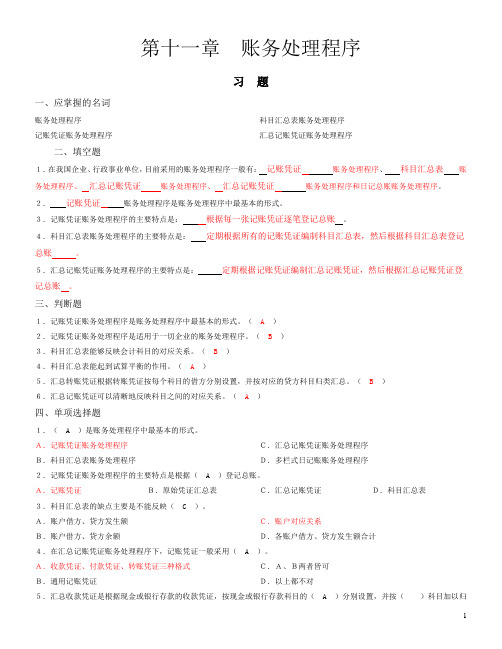
第十一章账务处理程序习题一、应掌握的名词账务处理程序记账凭证账务处理程序科目汇总表账务处理程序汇总记账凭证账务处理程序二、填空题1.在我国企业、行政事业单位,目前采用的账务处理程序一般有:记账凭证账务处理程序、科目汇总表账务处理程序、汇总记账凭证账务处理程序、汇总记账凭证账务处理程序和日记总账账务处理程序。
2.记账凭证账务处理程序是账务处理程序中最基本的形式。
3.记账凭证账务处理程序的主要特点是:根据每一张记账凭证逐笔登记总账。
4.科目汇总表账务处理程序的主要特点是:定期根据所有的记账凭证编制科目汇总表,然后根据科目汇总表登记总账。
5.汇总记账凭证账务处理程序的主要特点是:定期根据记账凭证编制汇总记账凭证,然后根据汇总记账凭证登记总账。
三、判断题1.记账凭证账务处理程序是账务处理程序中最基本的形式。
(A)2.记账凭证账务处理程序是适用于一切企业的账务处理程序。
(B)3.科目汇总表能够反映会计科目的对应关系。
(B)4.科目汇总表能起到试算平衡的作用。
(A)5.汇总转账凭证根据转账凭证按每个科目的借方分别设置,并按对应的贷方科目归类汇总。
(B)6.汇总记账凭证可以清晰地反映科目之间的对应关系。
(A)四、单项选择题1.( A )是账务处理程序中最基本的形式。
A.记账凭证账务处理程序B.科目汇总表账务处理程序C.汇总记账凭证账务处理程序D.多栏式日记账账务处理程序2.记账凭证账务处理程序的主要特点是根据( A )登记总账。
A.记账凭证B.原始凭证汇总表C.汇总记账凭证D.科目汇总表3.科目汇总表的缺点主要是不能反映( C )。
A.账户借方、贷方发生额B.账户借方、贷方余额C.账户对应关系D.各账户借方、贷方发生额合计4.在汇总记账凭证账务处理程序下,记账凭证一般采用( A )。
A.收款凭证、付款凭证、转账凭证三种格式B.通用记账凭证C.A、B两者皆可D.以上都不对5.汇总收款凭证是根据现金或银行存款的收款凭证,按现金或银行存款科目的( A )分别设置,并按()科目加以归类汇总。
会计学原理Financial Accounting by Robert Libby第八版 第十一章 答案
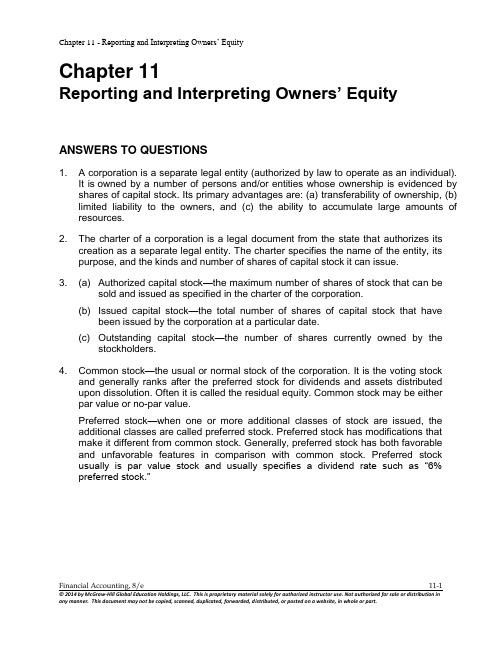
Chapter 11 - Reporting and Interpreting Owners’ EquityChapter 11Reporting and Interpreting Owners’ EquityANSWERS TO QUESTIONS1. A corporation is a separate legal entity (authorized by law to operate as an individual).It is owned by a number of persons and/or entities whose ownership is evidenced by shares of capital stock. Its primary advantages are: (a) transferability of ownership, (b) limited liability to the owners, and (c) the ability to accumulate large amounts of resources.2. The charter of a corporation is a legal document from the state that authorizes itscreation as a separate legal entity. The charter specifies the name of the entity, its purpose, and the kinds and number of shares of capital stock it can issue.3. (a) Authorized capital stock—the maximum number of shares of stock that can besold and issued as specified in the charter of the corporation.(b) Issued capital stock—the total number of shares of capital stock that havebeen issued by the corporation at a particular date.(c) Outstanding capital stock—the number of shares currently owned by thestockholders.4. Common stock—the usual or normal stock of the corporation. It is the voting stockand generally ranks after the preferred stock for dividends and assets distributed upon dissolution. Often it is called the residual equity. Common stock may be either par value or no-par value.Preferred stock—when one or more additional classes of stock are issued, the additional classes are called preferred stock. Preferred stock has modifications that make it different fromcommon stock. Generally, preferred stock has both favorable and unfavorable features in comparison with common stock. Preferred stock usually is par value stock and usually specifies a dividend rate such as ―6% preferred stock.‖Chapter 11 - Reporting and Interpreting Owners’ Equity5. Par value is a nominal per share amount established for the common stock and/orpreferred stock in the charter of the corporation, and is printed on the face of each stock certificate. The stock that is sold by a corporation to investors above par value is said to have sold at a premium, while stock that is sold below par is said to have sold at a discount. The laws of practically all states forbid the initial sale of stock by a corporation to investors below par value. No-par value stock does not have an amount per share specified in the charter. As a consequence, it may be issued at any price without involving a discount or a premium. It avoids giving the impression of a value that is not present.6. The usual characteristics of preferred stock are: (1) dividend preferences, (2)conversion privileges, (3) asset preferences, and (4) nonvoting specifications.7. The two basic sources of stockholders’ equity are:Contributed capital—the amount invested by stockholders by purchase from the corporation of shares of stock. It is comprised of two separate elements: (1) the par or stated amount derived from the sale of capital stock (common or preferred) and(2) the amount received in excess of par or stated value.Retained earnings—the accumulated amount of all net income since the organization of the corporation, less losses and less the accumulated amount of dividends paid by the corporation since organization.8. Stockholders’ equity is accounted for in terms of source. This means that severalaccounts are maintained for the various sources of stockholders’equity, such as common stock, preferred stock, contributed capital in excess of par, and retained earnings.9. Treasury stock is a corporation’s own capital stock that was sold (issued) andsubsequently reacquired by the corporation. Corporations frequently purchase shares of their own capital stock for sound business reasons, such as to obtain shares needed for employees’ bonus plans, to influence the market price of the stock, to increase earnings per share amounts, and to have shares on hand for use in the acquisition of other companies. Treasury stock, while held by the issuing corporation, confers no voting, dividend, or other stockholder rights.10. Treasury stock is reported on the balance sheet under stockholders’equity as adeduction; that is, as contra stockholders’equity. Any ―gain or loss‖ on treasury stock that has been sold is reported on the financial statements as an addition to contributed capital if a gain; if a loss, it is deducted from any previous contributed capital, or otherwise from retained earnings.Chapter 11 - Reporting and Interpreting Owners’ Equity11. The two basic requirements to support a cash dividend are: (1) cash on hand or theability to obtain cash sufficient to pay the dividend and (2) a sufficient balance in retained earnings, because the dividend represents a return of earnings to the stockholders. A cash dividend reduces both the assets of a corporation and stockholders’ equity by the amount of the dividend.12. Cumulative preferred stock has a dividend preference such that, should thedividends on the preferred stock for any year, or series of years, not be paid, dividends cannot be paid to the common stockholders until all such dividends in arrears are paid to the preferred stockholders. Noncumulative preferred stock does not have this preference; therefore, dividends not paid in past periods will never be paid to the preferred stockholders.13. A stock dividend involves the issuance to the stockholders of a dividend in thecorporation’s own stock (rather than cash). A stock dividend is significantly diffe rent from a cash dividend in that the corporation does not disburse any assets, while in the case of a cash dividend, cash is decreased by the amount of the dividend. A cash dividend also reduces total stockholders’ equity by the amount of the dividend.In contrast, a stock dividend does not change total stockholders’ equity.14. The primary purposes for issuing a stock dividend are: (1) to maintain dividendconsistency; that is, to pay dividends each year either in cash or in capital stock, and (2) to capitalize retained earnings; that is, a stock dividend requires a transfer from the Retained Earnings account to the permanent contributed capital accounts for the amount of the dividend. Although this transfer does not change stockholders’ equity in total, it does cause a shift from retained earnings to contributed capital. 15. When a dividend is declared and paid, the three important dates are:Declaration date—the date on which the board of directors votes the dividend. In the case of a cash dividend, a dividend liability comes into existence on this date and must be recorded as a debit to Retained Earnings and as a credit to Dividends Payable.Date of record—this date usually is about one month after the date of declaration. It is the date on which the corporation extracts from its stockholders’ records the list of individuals owning shares. The dividend is paid only to those names listed on the record date. No entry in the accounts is made on this date.Date of payment—the date on which the cash is disbursed to pay the dividend. It follows the date of record as specified in the dividend announcement. The entry to record the cash disbursement for the dividend is a debit to Dividends Payable anda credit to Cash.Chapter 11 - Reporting and Interpreting Owners’ Equity16. Retained earnings is the accumulated amount of all net income of the corporationless all losses and less the accumulated amount of all dividends declared to date.The primary components of retained earnings are: beginning balance, plus net income, less net losses, minus dividends declared, equals the ending balance.ANSWERS TO MULTIPLE CHOICE1. c)2. d)3. b)4. a)5. c)6. b)7. c)8. c)9. d) 10. a)Chapter 11 - Reporting and Interpreting Owners’ EquityAuthors’ Recommended Solution Time(Time in minutes)students will need to complete the assignment. As with any open-ended project, it is possible for students to devote a large amount of time to these assignments. While students often benefit from the extra effort, we find that some become frustrated by the perceived difficulty of the task. You can reduce student frustration and anxiety by making your expectations clear. For example, when our goal is to sharpen research skills, we devote class time to discussing research strategies. When we want the students to focus on a real accounting issue, we offer suggestions about possible companies or industries.Chapter 11 - Reporting and Interpreting Owners’ EquityMINI- EXERCISESM11–1.Stockholders may:a) Vote in the stockholders’ meeting (or by proxy) on major issues concerningmanagement of the corporation.b) Participate proportionately with other stockholders in the distribution of thecorporation’s profits.c) Share proportionately with other stockholders in the distribution of corporateassets upon liquidation.Being able to vote is the most important of the rights because this ensures that the owners have an input at the stockholders’ meeting and some control of the management of the corporation, thus enabling them to protect their rights as stockholders.M11–2.Unissued shares = 90,000 (268,000 – 178,000)M11–3.Cash (170,000 ⨯ $21) (+A) ...........................................3,570,000Common Stock (170,000 ⨯ $1) (+SE) ......................170,000 Capital in Excess of Par (+SE) .................................3,400,000 The journal entry would be different if the par value were $2:Cash (170,000 ⨯ $21) (+A) ...........................................3,570,000Common Stock (170,000 ⨯ $2) (+SE) ......................340,000 Capital in Excess of Par (+SE) .................................3,230,000Chapter 11 - Reporting and Interpreting Owners’ EquityM11–4.Common stock is the basic voting stock issued by a corporation. It ranks afterpreferred stock for dividends and assets distributed upon liquidation of thecorporation. The dividend rate for common stock is determined by the board of directors, and is based on the company’s profitability. The dividend rate forpreferred stock is fixed by a contract. Common stock has more potential for growth than preferred stock if the company is profitable. On the other hand, the investor may lose more money with common stock than with preferred stock if the company is not profitable.Usually, It is advisable to invest in the common stock if you believe the company will be profitable. Common stock will receive a higher return on the $100,000 than preferred stock would.Chapter 11 - Reporting and Interpreting Owners’ EquityM11–7.April 15:Retained Earnings (-SE) ..............................................65,000Dividends Payable (+L) ............................................65,000 June 14:Dividends Payable (-L) .................................................65,000Cash (-A) ..................................................................65,000M11–10.Retained Earnings (-SE) ..............................................800,000Common Stock (+SE) ..............................................800,000Chapter 11 - Reporting and Interpreting Owners’ EquityEXERCISESE11–1.Computation of End of Year Balance for Treasury Stock:Beginning balance 307,532,841Net increase 75,874,824Ending balance 383,407,665Computation of Shares Outstanding:Issued shares 2,109,316,331Treasury stock ( 383,407,665)Shares Outstanding 1,725,908,666E11–2.Req. 1 The number of authorized shares is specified in the corporate charter: 300,000. Req. 2 Issued shares are the shares sold to the public: 160,000Req. 3 Issued shares 160,000Treasury stock (25,000)Outstanding shares 135,000Chapter 11 - Reporting and Interpreting Owners’ EquityE11–3.Req. 1Stockholders’ EquityContributed capital:Preferred stock, authorized 4,000 shares,issued and outstanding, 3,000 shares ...................................................... $ 24,000 Common stock, authorized 103,000 shares,issued and outstanding, 20,000 shares .................................................... 200,000 Capital in excess of par, preferred .............................................................. 36,000 Capital in excess of stated value, no-par common ..................................... 120,000 Total contributed capital .......................................................................... 380,000 Retained earnings .......................................................................................... 60,000 Total Stockholders’ Equity....................................................................... $440,000 Req. 2The answer would depend on the profitability of the company and the stability of its earnings. The preferred stock has a 9% dividend rate. If the company earns more than 9%, the additional earnings would accrue to the current stockholders. If the company earns less than 9%, it would pay a higher rate to the preferred stockholders.E11–4.Req. 1 ($30 x 90,000 shares) - $1,600,000 = $1,100,000Req. 2 $900,000 - $1,000,000 + $800,000 = $700,000Req. 3 90,000 shares – 80,000 shares = 10,000 sharesReq. 4 EPS = $1,000,000 80,000 = $12.50Chapter 11 - Reporting and Interpreting Owners’ EquityE11–5.Req. 1a. Cash (5,600 shares x $20) (+A) ............................................ 112,000Common stock (5,600 shares x $10) (+SE) ...................... 56,000 Capital in excess of par, common stock (+SE) .................. 56,000 Sold common stock at a premium.b. Cash (1,000 shares x $25) (+A) ............................................ 25,000Common stock (1,000 shares x $10) (+SE) ...................... 10,000 Capital in excess of par, common stock (+SE) .................. 15,000 Sold common stock at a premium.Req. 2Stockholders’ EquityContributed capital:Common stock, par $10, authorized 11,500 shares,outstanding 6,600 shares .................................................................... $ 66,000 Contributed capital in excess of par ........................................................ 71,000 Total contributed capital .......................................................................... 137,000 Retained earnings ...................................................................................... 12,000 Stockholders’ equity ................................................................................... $149,000Chapter 11 - Reporting and Interpreting Owners’ EquityE11–6.Req. 1Common stock, class A at par value: 118,529,925 X $0.01 = $1,185 (thousand)Req. 2(Note that this solution is based on the number of Class A common shares that are outstanding. We elect not to include the Class B shares because they are owned by the Dillard family. Usually, students do not question this assumption but when they do, it permits us to discuss reasons for issuing different types of common stock. In this case, owners of Class B shares are permitted to elect two-thirds of the board of directors, effectively letting the founding family maintain control of a public company).Number of shares outstanding 2012: 118,529,925 shares issued minus 73,099,319 shares held as treasury stock = 45,430,606.Number of shares outstanding 2011: 117,706,523 shares issued minus 61,740,439 shares held as treasury stock = 55,966,084.Req. 3(In thousands) Retained earnings for 2011: $3,107,344minusnet income for 2012 $463,909 plus dividends for 2012 $10,002 = $2,653,437Req. 4As of 2012, treasury stock had decreased corporate resources by $1,846,312 (thousand).Req. 5T reasury stock transactions decreased stockholders’ equity by $490,786 (thousand) ($1,846,312 - $1,355,526).Req. 6For 2012, treasury stock cost per share: $1,846,312 (thousand) ÷ 73,099,319 shares = $25.26.Chapter 11 - Reporting and Interpreting Owners’ EquityE11–7.Req. 1a. Cash (50,000 shares x $50) (+A) .......................................... 2,500,000Common stock (50,000 shares x $2) (+SE) ...................... 100,000 Capital in excess of par, common stock (+SE) .................. 2,400,000 Sold common stock at a premium.b. Treasury stock (2,000 shares x $52) (+XSE, -SE) ................ 104,000Cash (-A) ........................................................................... 104,000 Bought treasury stock.Req. 2Stockholders’ EquityContributed capital:Common stock, par $2, authorized 80,000 shares,issued 50,000 shares .......................................................................... $ 100,000 Contributed capital in excess of par ........................................................ 2,400,000 Total contributed capital .......................................................................... 2,500,000 Treasury stock............................................................................................ (104,000 ) Stockholders’ equity ................................................................................... $2,396,000 E11–8.Shareholders’ equity (deficit) in thousands: 2010 2011 Common stock, par value $.01 per share; 100,000,000 shares authorized,33,981,509 shares issued and outstanding at December 31, 2010,34,150,389 shares issued and outstanding at December 31, 2011 340 342 Additional paid-in capital 198,304 200,524 Accumulated deficit (118,282 ) (98,733 ) Total shareholders’ equity80,362 102,133Chapter 11 - Reporting and Interpreting Owners’ EquityE11–9.Stockholders’ EquityContributed capital:Preferred stock, 8%, par $50, authorized 59,000 shares,issued and outstanding, 20,000 shares ............................................... $1,000,000 Common stock, par $10, authorized 98,000 shares,issued, 78,000 shares ......................................................................... 780,000 Capital in excess of par, preferred stock ................................................. 600,000 Capital in excess of par, common stock .................................................. 780,000 Treasury stock ..................................................................................... (80,000) Retained earnings* ......................................................................................... 160,000 Total stockholders’ equity........................................................................ $3,240,000 *($210,000 – $50,000 = $160,000.)E11–10.Req. 1a. Cash (20,000 shares x $20) (+A) .......................................... 400,000Common stock, no-par (+SE) ............................................ 400,000 .b. Cash (6,000 shares x $40) (+A) ............................................ 240,000Common stock, no-par (+SE) ........................................... 240,000 c. Cash (7,000 shares x $30) (+A) ............................................ 210,000Preferred stock (7,000 shares x $10) (+SE) ...................... 70,000 Capital in excess of par, preferred (+SE) .......................... 140,000 Req. 2Yes, it is ethical as long as there is a fu ll disclosure of relevant information. In any arm’s length transaction, an informed buyer will pay the market value of the stock.Chapter 11 - Reporting and Interpreting Owners’ EquityE11–11.Req. 1Number of preferred shares issued: $100,000 $10 = 10,000Req. 2Number of preferred shares outstanding: 10,000 shares issued minus 500 shares held as treasury stock = 9,500.Req. 3Average sales price per share of preferred stock when issued: ($100,000 + $15,000) ÷10,000 shares = $11.50.Req. 4Decreased corporate resources by $9,500 - $1,500 = $8,000.Req. 5Treasury stock transactions decreased stockholders’ equity by $8,000 (same as the decrease in corporate resources in 4 above).Req. 6Treasury stock cost per share: $9,500 ÷ 500 shares = $19.00.Req. 7Total stockholders’ equity: $741,000.Req. 8Issue price of common stock $600,000 ÷ 8,000 shares = $75.00.Chapter 11 - Reporting and Interpreting Owners’ EquityE11–12.Req. 1The number of shares that have been issuedis computed by dividing the common stock account ($4,008 million) by the par value of the shares ($1 per share) or approximately 4,008,000,000 shares.Req. 2Retained earnings end of 2011 ............ $70,682,000,000Net income for 2012 ............................ 10,756,000,000Dividends for 2012 ............................... (5,811,600,000 )Retained earnings end of 2012 ............ $75,626,400,000The amount of retained earnings is an estimate because we do not know the exact number of shares outstanding (because we do not know the number of shares in treasury stock). This number is needed to determine the amount of dividends paid during 2012. We based the dividends on the estimate calculated in the previous requirement.E11–13.The treasury stock account is a contra equity account, meaning that it subtracts from the total stockholders’ equity. Cash also decreases on the balance sheet by the same amount.Req. 2Many companies repurchase common stock in order to develop an employee bonus plan that provides workers with shares of the company’s stock as part of their compensation. Because of SEC regulations concerning newly issued shares, companies find it cheaper to give their employees shares of stock that were purchased from stockholders than to issue new shares. In this case, the company mentions the goal of enhancing shareholder s’ value. If the company maintains its current level of income, earnings per share will increase with fewer shares outstanding. The management expects that the increase in EPS will be reflected in an increase in stock price.Req. 3Shares that are held in treasury stock do not participate in dividend payments. As a result, the purchase of treasury stock will reduce the amount of dividends that the company must pay in future years.Chapter 11 - Reporting and Interpreting Owners’ EquityE11–14.Req. 1Stockholders’ EquityContributed capital:Common stock, authorized 100,000 shares, issued 34,000 shares, ofwhich 2,000 shares are held as treasury stock .................................. $680,000 Capital in excess of par ........................................................................ 163,000 Total contributed capital .................................................................... 843,000 Retained earnings ................................................................................... 89,000 Total .................................................................................................. 932,000 Less: Cost of treasury stock ................................................................. 25,000 Total Stockholders’ Equity$907,000 Req. 2The dividend yield ratio is 2.24% ([$16,000 ÷ 32,000 shares] ÷ $22.29). While this yield seems small, it is a typical return on common stock. Investors receive a return from both dividends and stock price appreciation.Treasury stock does not receive dividends. As a result, dividends should be paid on 32,000 shares.E11–15.Req. 1a. Treasury stock (200 shares x $20) (+XSE, -SE) ................... 4,000Cash (-A) ........................................................................... 4,000 Bought treasury stock.b. Cash (40 shares x $25) (+A) ................................................. 1,000Treasury stock(40 shares x $20) (-XSE, +SE) (800)Capital in excess of par (+SE) (200)Sold treasury stock.c. Cash (30 shares x $15) (+A) (450)Capital in excess of par (-SE) (150)Treasury stock (30 shares x $20) (-XSE, +SE) (600)Sold treasury stock.Req. 2It is not possible to make a ―profit‖ o r ―loss‖ on treasury stock transactions. Therefore, these transactions do not affect the income statement.Chapter 11 - Reporting and Interpreting Owners’ EquityE11–16.Req. 1Feb. 1:Treasury stock, common (160 shares x $20) (+XSE, -SE) 3,200Cash (-A) ........................................................................ 3,200 July 15:Cash (80 shares x $21) (+A) ............................................. 1,680Treasury stock, common (-XSE, +SE) ........................... 1,600 Capital in excess of par (+SE) (80)Sept. 1:Cash (50 shares x $19) (+A) (950)Capital in excess of par (-SE) (50)Treasury stock, common (50 shares x $20) (-XSE, +SE) 1,000.Req. 2Dividends are not paid on treasury stock. Therefore, the amount of total cash dividends paid is reduced when treasury stock is purchased.Req. 3The sale of treasury stock for more or less than its original purchase price does not have an impact on net income. The transaction affects only balance sheet accounts. The cash received from the sale of treasury stock is a cash inflow which would affect the Statement of Cash Flows in the financing activities section.Chapter 11 - Reporting and Interpreting Owners’ EquityE11–17.Req. 1Case 1: When companies unexpectedly announce increases in dividends, stock prices typically increase. Depending on course objective, the instructor may want to discuss research in finance concerning dividend policy.Case 2: Stock price is based on expectations. If the increase in operatingperformance was not expected, the stock price should increase. It is not necessary to increase dividends to have a favorable stock price reaction.Case 3: Stock dividends do not provide any economic value but they may have a signal effect and are often associated with increases in cash dividends. As a result, stock dividends do not appear to directly cause an increase in stock price but are often associated with factors that do impact favorably on price.Req.2Stock prices react to underlying economic events and not changes in reportingmethods, per se. Markets are relatively effective in recognizing the differencebetween profits generated by operations and profits generated by the use of liberal accounting policies.Chapter 11 - Reporting and Interpreting Owners’ Equity E11–18.Req. 1 Preferred(5,000Shares)Common(50,000Shares) Totala) Noncumulative:Preferred ($50,000 x 10%) ...................................... $ 5,000 $ 5,000 Balance to common ($85,000 – $5,000) ................. $80,000 80,000$ 5,000 $80,000 $85,000 b) Cumulative:Preferred, arrears ($50,000 x 10% x 2 years) ......... $ 10,000 $ 10,000 Preferred, current year ($50,000 x 10%) ................. 5,000 5,000 Balance to common ($85,000 – $10,000 – $5,000) $70,000 70,000$15,000 $70,000 $85,000Req. 2The total dividend amount and dividends per share of common stock were less underthe second assumption because the preferred stock preferences increased while at the same time the total dividend amount remained stable.Req. 3Larger total dividend distributionsare more favorable for the common stockholders.E11–19.ItemEffect of Cash Dividend (Preferred) Effect of Stock Dividend (Common)Assets –No effect on declaration date.–Decreased by the amount of thedividend ($7,200) on paymentdate. No effect because no assets are disbursed.Liabilities –Increased on declaration date($7,200).–Decreased on payment date($7,200). No effect—no entry on declaration date because no contractual liability is created (no assets are disbursed).Stockholders’equity Decreased by the amount of thedividend (retained earningsdecreased by $7,200).–Total stockho lders’ equity notchanged.–Retained earnings reduced andcontributed capital increased bysame amount ($120,000).。
会计学原理第十一章会计核算组织程序
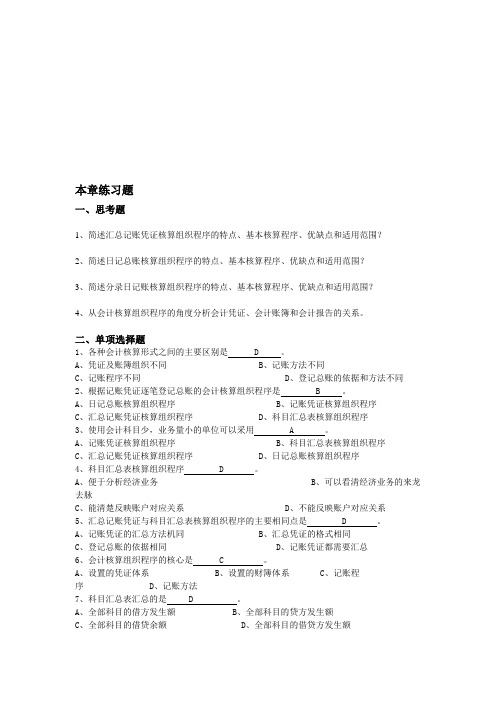
本章练习题一、思考题1、简述汇总记账凭证核算组织程序的特点、基本核算程序、优缺点和适用范围?2、简述日记总账核算组织程序的特点、基本核算程序、优缺点和适用范围?3、简述分录日记账核算组织程序的特点、基本核算程序、优缺点和适用范围?4、从会计核算组织程序的角度分析会计凭证、会计账簿和会计报告的关系。
二、单项选择题1、各种会计核算形式之间的主要区别是 D 。
A、凭证及账簿组织不同B、记账方法不同C、记账程序不同D、登记总账的依据和方法不同2、根据记账凭证逐笔登记总账的会计核算组织程序是 B 。
A、日记总账核算组织程序B、记账凭证核算组织程序C、汇总记账凭证核算组织程序D、科目汇总表核算组织程序3、使用会计科目少,业务量小的单位可以采用 A 。
A、记账凭证核算组织程序B、科目汇总表核算组织程序C、汇总记账凭证核算组织程序D、日记总账核算组织程序4、科目汇总表核算组织程序 D 。
A、便于分析经济业务B、可以看清经济业务的来龙去脉C、能清楚反映账户对应关系D、不能反映账户对应关系5、汇总记账凭证与科目汇总表核算组织程序的主要相同点是 D 。
A、记账凭证的汇总方法机同B、汇总凭证的格式相同C、登记总账的依据相同D、记账凭证都需要汇总6、会计核算组织程序的核心是 C 。
A、设置的凭证体系B、设置的财簿体系C、记账程序 D、记账方法7、科目汇总表汇总的是 D 。
A、全部科目的借方发生额B、全部科目的贷方发生额C、全部科目的借贷余额D、全部科目的借贷方发生额8、科目汇总表与汇总记账凭证都属于 C 。
A、原始凭证B、汇总的原始凭证C、汇总的记账凭证 D、转账凭证9、汇总记账凭证核算形式的适用范围是 A 。
A、规模较大,业务较多的单位B、规模较小,业务较少的单位C、规模较大,业务较少的单位D、规模较小,业务较多的单位10、汇总记账凭证核算形式的主要缺点是 B 。
A、登记总账的工作量大B、不利于人员分工C、体现不了账户对应关系D、明细账与总账无法核对11、在汇总记账凭证核算形式下,对于平时所编的转账凭证上的科目对应关系应保持 D 。
初级会计学 第十一章练习题(含答案)

第十一章会计档案习题一、单项选择题1.档案部门接收保管的会计档案需要拆封重新整理时,正确的做法是( D )。
A.由原封装人员拆封整理 B.由原财务会计部门拆封整理C.由档案部门拆封整理D.由档案部门会同原财务会计部门和经办人员共同拆封整理2.根据《会计档案管理办法》规定,企业银行存款余额调节表的保管期限为( B )。
A.1年 B.5年 C.10年 D.15年3.根据《会计档案管理办法》规定,企业库存现金日记账和银行存款日记账的保管期限为( C )。
A.10年 B.15年 C.25年 D.永久4.根据《会计档案管理办法》规定,企业季度财务会计报告的保管期限为( A )年。
A.3 B.5 C.10 D.155.下列会计档案中,应永久保管的是( D )。
A.库存现金日记账 B.原始凭证 C.总分类账 D.年度财务会计报告(决算)6.企业的月度财务会计报告及其说明文字应保管( A )年。
A.3 B.5 C.15 D.257.根据《会计档案管理办法》规定,企业原始凭证的保管期限为( C )年。
A.3 B.5 C.15 D.258.下列会计档案保管期满时仍不能销毁的是( B )。
A.会计移交清册 B.涉及到未了事项的原始凭证C.计算机输出的月度报表 D.涉及到未了事项的月度报表9.某企业2002年8月6日收到其开户银行的5月份银行对账单,按规定应保存至( D )。
A.企业清算完毕 B.2007年2月28日C.2007年3月6日 D.2007年12月31日10.下列资料中,不属于会计凭证类会计档案的是( C )。
A.原始凭证 B.汇总凭证 C.辅助账簿 D.记账凭证11.各单位每年形成的会计档案,都应由本单位( A )负责整理立卷,装订成册,编制会计档案保管清册。
A.财务会计部门 B.档案部门 C.人事部门 D.指定专人12.企业单位和行政单位的固定资产卡片的保管期限为( D )。
A.固定资产清理报废时 B.固定资产清理报废后1年C.固定资产清理报废后2年 D.固定资产清理报废后5年13.国家机关销毁会计档案时,应由( B )派员监销。
会计学(第二版)课后习题答案_(第九至十三章)

取得时
借:银行存款
1037184
贷:应付债券—面值
1000000
利息调整
37184
2007 年 7 月 1 日,债券溢价摊销时
借:财务费用
31115.52
应付债券—利息调整
8884.48
贷:应付利息
40000
实际支付利息时
借:应付利息
40000
贷:银行存款
40000
2008 年 1 月 1 日、2008 年 7 月 1 日,溢价摊销和支付利息费用同上。
1.ABCD 2.AC 3.AC 10.AC 11.AB 12.ABC 19.AC 20.ACD
4.ABC 5.AB 6.ABD 7.ABCD 13.ABC 14.AB 15.ABD 16.AB
8.BCD 9.ABC 17.BC 18.ACD
三、是非题 1.对 2.对 3.错 4.对 5.对 6.对 7.错 8.对 9.错 10.错 11.错 12.对 13.错
600000 300000 1200000 300000
206000 86000
7
(3)借:原材料
60000
应交税费—应交增值税(进项税额) 10200
贷:实收资本
(4)借:盈余公积
300000
贷:利润分配—其他转入
(5)应纳税所得=350000+8000=358000(元)
税后利润=350000-118140=231860(元)
贷:盈余公积—法定盈余公积
任意盈余公积
(2)借:盈余公积 贷:利润分配—其他转入
(3)借:盈余公积 贷:股本
1200000 300000
(1)借:固定资产 贷:实收资本
基础会计学课后答案 清华大学出版社 doc版
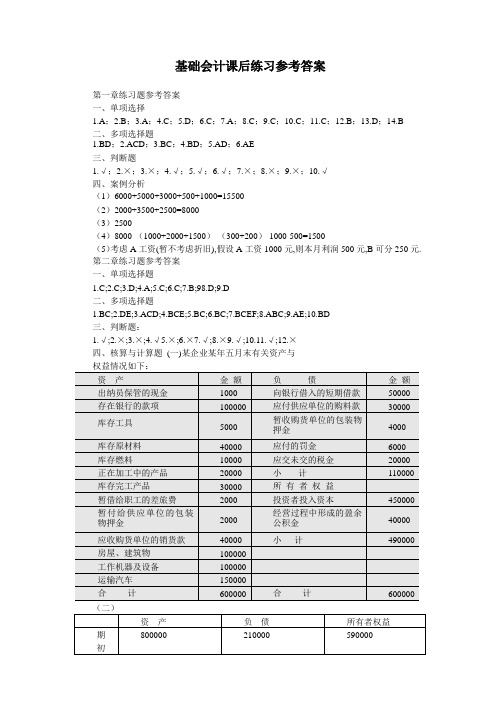
基础会计课后练习参考答案第一章练习题参考答案一、单项选择1.A;2.B;3.A;4.C;5.D;6.C;7.A;8.C;9.C;10.C;11.C;12.B;13.D;14.B二、多项选择题1.BD;2.ACD;3.BC;4.BD;5.AD;6.AE三、判断题1.√;2.×;3.×;4.√;5.√;6.√;7.×;8.×;9.×;10.√四、案例分析(1)6000+5000+3000+500+1000=15500(2)2000+3500+2500=8000(3)2500(4)8000-(1000+2000+1500)-(300+200)-1000-500=1500(5)考虑A 工资(暂不考虑折旧),假设A 工资1000 元,则本月利润500 元,B 可分250 元.第二章练习题参考答案一、单项选择题1.C;2.C;3.D;4.A;5.C;6.C;7.B;98.D;9.D二、多项选择题1.BC;2.DE;3.ACD;4.BCE;5.BC;6.BC;7.BCEF;8.ABC;9.AE;10.BD三、判断题:1.√;2.×;3.×;4.√5.×;6.×7.√;8.×9.√;10.11.√;12.×四、核算与计算题(一)某企业某年五月末有关资产与第三章练习题参考答案一、单项选择题1.B;2.D;3.C;4.A;5.C;6.B;7.B;8.A;9.D;10.A二、多项选择题1.BCDE;2.ASC;3.ADE;4.ABC;5.AB;6.ACD;7.ADE;8.AB;9.ABC;10.AB;11.BC;12.BCE;13.CD;14.CE;15.ABD;三、判断题1.×;2.√;3.×;4.×;5.×;6.×;7.×;8.×;9.×;10.√;11.√12.×;13. √;14.×四、计算题第四章练习题参考答案一、单项选择题:1.D;2.B;3.C;4.D;5.C;6.C;7.B;8.B二、多项选择题:1.ACD;2.ABCD;3.CD;4.BCE;5.ABC;6.BCD;7.ABC;8.ABCE;9.AD;10.DE三、判断题1.×;2.√;3.√;4.√;5.√第五章练习题参考答案一、单项选择题:1.A;2.D;3.D;4.C;5.B;6.D;7.C;8.D;9.B;10.A;11.A;12.B;13.C;14.D二、多项选择题1.ABD;2.ADE;3.BC;4.AE;5.CE;6.AE;7.ACD;8.ACD;9.AD;10.ABC;11.BDE;12.BD;三、判断题1.√;2.×;3.×;4.×;5.√;6.√;7.×;8.×四、核算与计算题第六章练习题参考答案一、单项选择题1.C ;2.C ;3.D ;4.B ;5.A ;6.B ;7.D ;8.B ;9.A ;10.C 二.、多项选择题。
- 1、下载文档前请自行甄别文档内容的完整性,平台不提供额外的编辑、内容补充、找答案等附加服务。
- 2、"仅部分预览"的文档,不可在线预览部分如存在完整性等问题,可反馈申请退款(可完整预览的文档不适用该条件!)。
- 3、如文档侵犯您的权益,请联系客服反馈,我们会尽快为您处理(人工客服工作时间:9:00-18:30)。
第十一章财务报表
一、单项选择题
1.会计报表中项目的数字直接来源于()。
A.原始凭证
B.记账凭证
C.日记账
D.账簿记录
2.财务报表是指企事业单位对外提供的反映企事业单位某一特定日期财务状况以及某一会计期间经营成果、现金流量等会计信息的文件,主要是由()组成的。
A.资产负债表和利润表
B.资产负债表、利润表和现金流量表
C.会计报表和财务情况说明书
D.会计报表和附注
3.将报表分为静态报表和动态表示按报表的()划分的。
A.服务对象
B.编报主体
C.编报时间
D.经济内容
4.资产负债表中的报表项目()。
A.都是根据账户余额直接填列
B.都是对账户发生额进行分析计算后填列
C.大多数项目可以直接根据账户余额填列,少数报表项目需要根据有关账户发生额分析计算后才能填列
D.大多数项目可以直接根据账户余额填列,少数报表项目需要根据有关账户余额分析计算后才能填列
5.资产负债表中,“应收账款”项目应根据()填列。
A.“应收账款”总分类账户期末余额
B.“应收账款”总分类账户所属明细账的期末余额
C.“应收账款”和“应付账款”中所属各明细分类账户的期末借方余额合计
D.“应收账款”和“预收账款”总分类账所属各明细分类账户的期末借方余额合计
6.多步式利润表是通过多步计算来确定当期损益的,通常把利润的计算分解
为()。
A.营业利润、利润总额、净利润和每股收益
B.营业收入、营业利润、应税利润和净利润
C.营业收入、营业利润、利润总额和净利润
D.营业利润、利润总额和净利润
二、多项选择题
1.会计报表主要包括()。
A.资产负债表
B. 利润表
C.现金流量表
D.所有者权益变动表
E.报表附注
2. 财务报告的使用者有()。
A.投资者
B.债权人
C.捐赠者
D.上级主管部门和财税部门
E.其内部管理人员和广大职工群众
3.下列报表中,属于内部报表的是()。
A.单位报表
B.商品产品成本表
C.制造费用明细表
D.期间费用明细表
E.产品成本明细表
4. 资产负债表中的“存货”项目应根据()等账户的期末借方余额之和填列。
A.原材料
B.生产成本
C.工程物资
D.库存商品
E.在途物资
5.下列账户中,可能影响资产负债表中“应付账款”项目的有()。
A.应收账款
B.预收账款
C.应付账款
D.预付账款
E.应付票据
6.利用资产负债表资料,可以()。
A.了解企业的资产总额及其分布和结构
B.了解企业负债总额及其结构
C.了解企业短期偿债能力和支付能力
D.了解企业股东权益总额及其结构
E.判断企业财务状况的发展趋势
7. 填报资产负债表期末数,可以分别采用的具体方法有()。
A.根据总账科目的期末余额直接填列
B.根据明细账科目的期末余额直接填列
C.根据若干总账科目的期末余额分析、计算后填列
D.根据若干明细科目的期末余额分析、计算后填列
E.根据会计凭证直接填列
8.编制利润表时,可根据结转前科目余额方向分析填列的项目有()。
A.营业收入
B.投资收益
C.资产减值损失
D.营业成本
E.公允价值变动损益
三、判断题
1.我国资产负债表的报表格式既可采用报告式,也可采用账户式。
()
2.利润表是反映企业在特定日期经营成果的报表。
()
3.每个企业都必须按月编报资产负债表、利润表、现金流量表和所有者权益变动表。
()
4.资产负债表的“年初余额”栏各项目数字,应根据上年末资产负债表“期末余额”栏内所列数字填列。
()
5.利润表中“本期金额”应根据各有关资产负债、所有者权益和损益类账户的本期发生额计算填列。
()
6.资产负债表月报中“未分配利润”项目是根据“本年利润”账户和“利润分配”账户余额计算填列的。
()
四、填表题
1. ABC公司2008年全年累计发生额如下:
主营业务收入(贷方)520 000
主营业务成本(借方)200 000
营业税金及附加(借方)50 000
其他业务收入(贷方)120 000
其他业务成本(借方)30 000
投资收益(贷方)20 000
营业外收入(贷方)45 000
管理费用(借方)27 000
财务费用(借方)8 000
销售费用(借方)30 000
营业外支出(借方)20 000
所得税费用(借方)105 600
要求:编制该公司2008年度的利润表
利润表
2.ABC公司2009年假设有关总分类账户和明细分类账户12月31日期末余额
根据上述资料填列资产负债表(下表)的部分有关项目。
资产负债表(部分)
五、综合题
(一)资料:假设ABC公司2009年9月30日资产负债表中有关数据如下:
(二)该公司2009年10月月份发生如下经济业务:
1.以银行存款购进固定资产100 000元;
2.用银行存款偿还应付账款200 000元;
3.接受某单位追加投资设备一台,价值500 000元;
4.收回应收账款200 000元,存入银行;
5.预收其他单位货款100 000元,存入银行。
(三)要求:
1.依据资料(二)编制该公司10月份相关会计分录;
2.依据资料(一)和资料(二)编制该公司2009年10月份简易资产负债表。
格式如下:
资产负债表(简表)
第十一章财务报表参考答案
一、单项选择题
1.D 2.D 3.D 4.D 5.D 6.A
二、多项选择题
1.ABCDE 2.ABDE 3.BCDE 4.ABDE 5.CD 6.ABCDE;7.ACD 8.BE
三、判断题
1.×
2.×
3.√
4.√
5.×
6.√
四、填表题
1.
利润表
2.
资产负债表(部分)
五、综合题
1.依据资料(二)编制相关会计分录
(1)借:固定资产100 000
贷:银行存款100 000
(2)借:应付账款200 000
贷:银行存款200 000
(3)借:固定资产500 000
贷:实收资本500 000
(4)借:银行存款400 000
贷:应收账款400 000
(5)借:银行存款100 000
贷:预收账款100000
2.依据资料(一)和资料(二)编制该公司2009年10月份简易资产负债表。
资产负债表(简易)。
